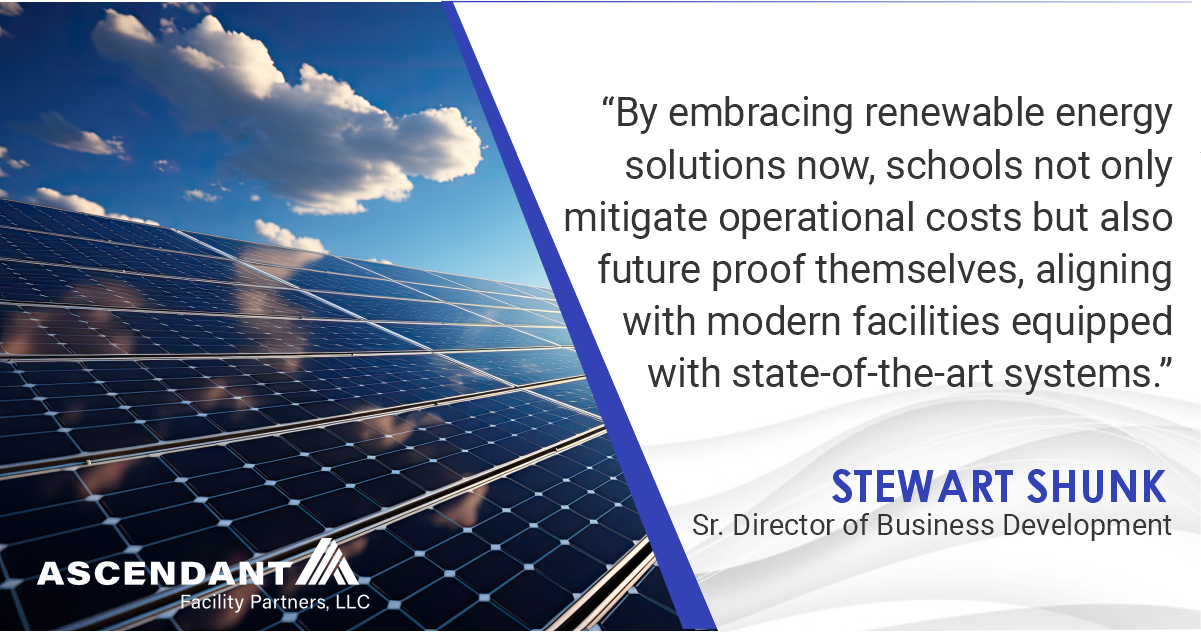Illuminating Education: Powering the Future with Solar Energy
As the world navigates the complexities of a rapidly evolving climate landscape, the imperative to embrace sustainable energy solutions has never been more pressing. Among the myriad avenues towards environmental stewardship, the integration of solar energy into public facilities, particularly schools, stands out as a beacon of progress. In this journey towards a greener future, Stewart Shunk, Sr. Director of Business Development at Ascendant Facility Partners (AFP), sheds light on the transformative power of solar integration in educational settings.
By embracing solar energy, schools not only contribute to the larger goal of reducing dependence on fossil fuels but also position themselves as pioneers in environmental stewardship and sustainability education. Beyond the tangible benefits of cost savings and operational efficiency, solar integration fosters a culture of innovation and responsibility within educational institutions. By harnessing the power of renewable energy, schools empower students to become agents of change, instilling in them a deep-seated commitment to preserving the planet for future generations. Thus, the decision to adopt solar energy transcends mere financial considerations, embodying a profound commitment to shaping a brighter, more sustainable future for all.
Incentivizing Solar Integration: Federal Support for Public Facilities
Federal support for solar integration in public facilities emerges as a cornerstone of environmental policy. By incentivizing the adoption of solar energy, governments aim not only to mitigate the environmental impact of traditional energy sources but also to foster economic resilience and energy independence.
“The incentive for the federal government to subsidize the cost of public facilities getting solar is to put more ‘green’ sustainable power in place, reducing our country’s dependence on fossil fuels,” explains Stewart, emphasizing the broader long-term sustainability goal.

Shunk highlights, “Its a ‘Direct Pay’ tax credit being issued to a tax-exempt public entity, similar to a rebate. This is highly effective in reducing the payback of the solar generation by up to 50% to the public entity.” He underscores the significant financial impact of these credits in making solar energy financially feasible for schools.
With the Direct Pay tax credit in play, schools stand to reap substantial financial rewards from solar integration. By receiving a rebate equivalent to up to 50% of the solar generation’s cost (depending on Federal qualifying criteria), educational institutions can significantly reduce their financial burden. This influx of funds opens new avenues for investment allowing schools to redirect resources towards critical areas such as educational programs, facility upgrades, and student support initiatives.
Moreover, the long-term savings generated from reduced energy bills provide schools with a sustainable source of financial stability, freeing up resources for strategic planning and future growth. In essence, the Direct Pay tax credit not only makes solar energy financially feasible for schools but also empowers them to thrive in an increasingly competitive educational landscape.
Mitigating Operational Expenses through Solar Integration
Operational expenses pose a significant challenge for schools with utilities ranking as the second highest line item in their budgets. “Operational expenses are a constant concern for schools, and utilities often eat up a considerable portion of their budgets, taking precious funds away from student learning” notes Stewart. “With solar integration, we’re not just talking about saving money on energy bills; we’re talking about transforming how schools manage their resources. By reducing facility loads by 30-40%, solar energy becomes more than just a cost-saving measure, it’s an investment in long-term financial stability. And with the unpredictability of energy prices, solar serves as a reliable hedge against future inflation, ensuring that schools can focus their resources where they matter most: on education.”
The Long-Term Outlook: Communicating Value Beyond Immediate Returns
Looking ahead, the integration of solar energy into school facilities represents a strategic investment in the future vitality of educational institutions. By leveraging Guaranteed Energy Savings Contracts (GESC) as a delivery method and embracing renewable energy solutions, schools position themselves as leaders in sustainability and innovation.
“As we gaze into the future, the integration of solar energy illuminates a path towards both fiscal responsibility and educational excellence,” remarks Stewart. “By embracing renewable energy solutions now, schools not only mitigate operational costs but also future proof themselves, aligning with modern facilities equipped with state-of-the-art systems. Through initiatives like Guaranteed Energy Savings Contracts, educational institutions can leverage solar power to not just save costs today but also to remain relevant and competitive in tomorrow’s rapidly evolving landscape.”

Educational Opportunities and Technological Advancements
Beyond financial savings and environmental impact, solar integration presents unparalleled educational opportunities. Real-time monitoring of solar generation and hands-on engagement with renewable energy technologies empower students to become active participants in shaping a more sustainable world.
As Stewart’s insights illuminate, federal support through the 48C Direct Pay Tax Incentive is pivotal in making solar energy financially viable for public institutions. By embracing solar technology, schools not only reduce operational expenses but also pave the way for a more sustainable future; one illuminated by the promise of renewable energy. Through strategic investments in solar integration and educational initiatives, schools emerge as catalysts for environmental progress, community resilience, and educational innovation.
